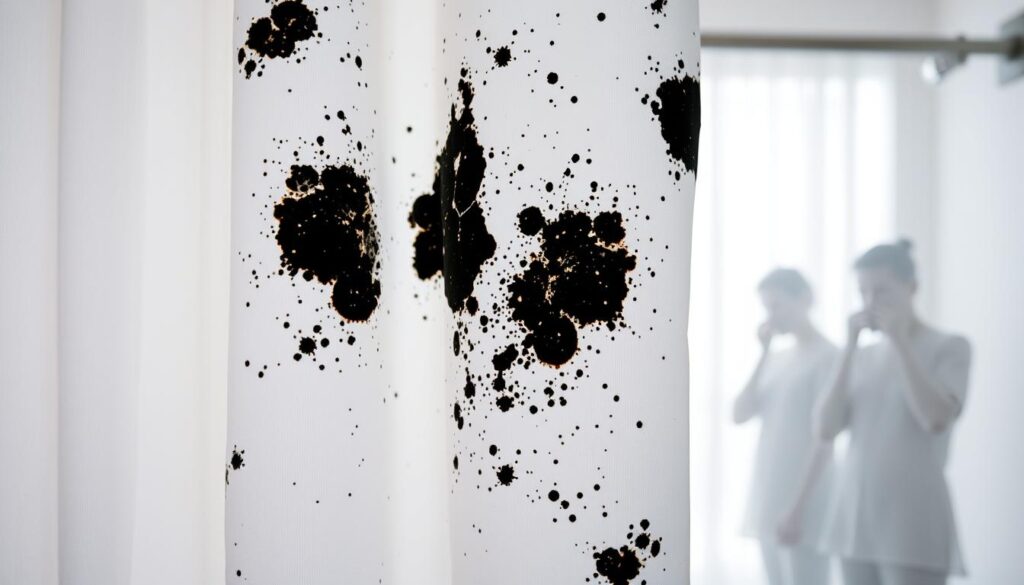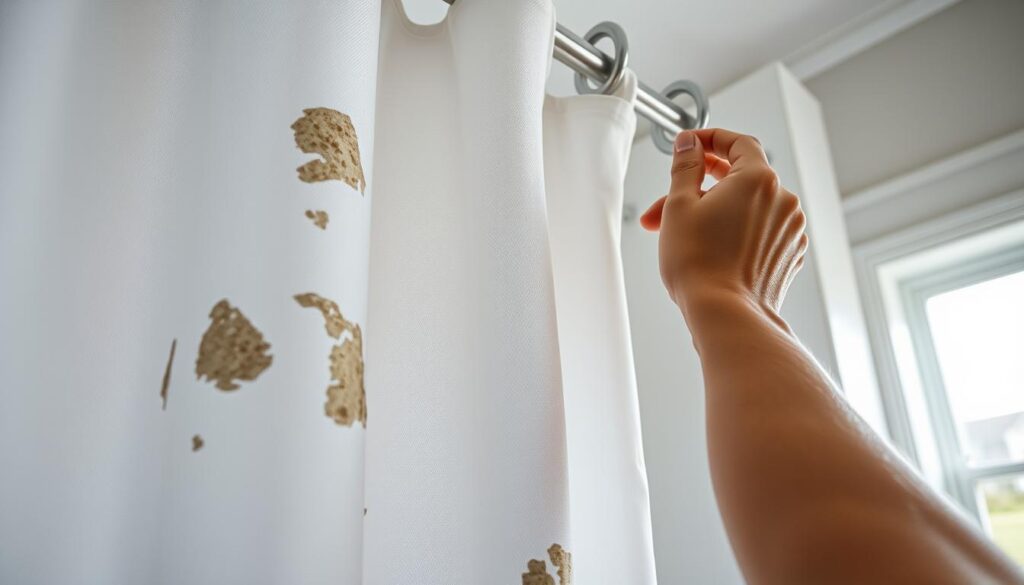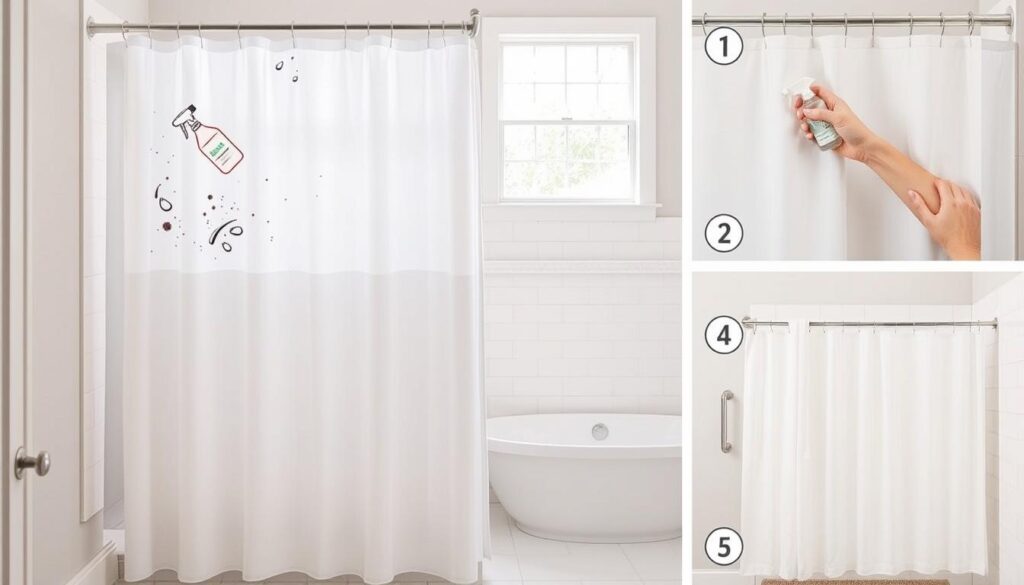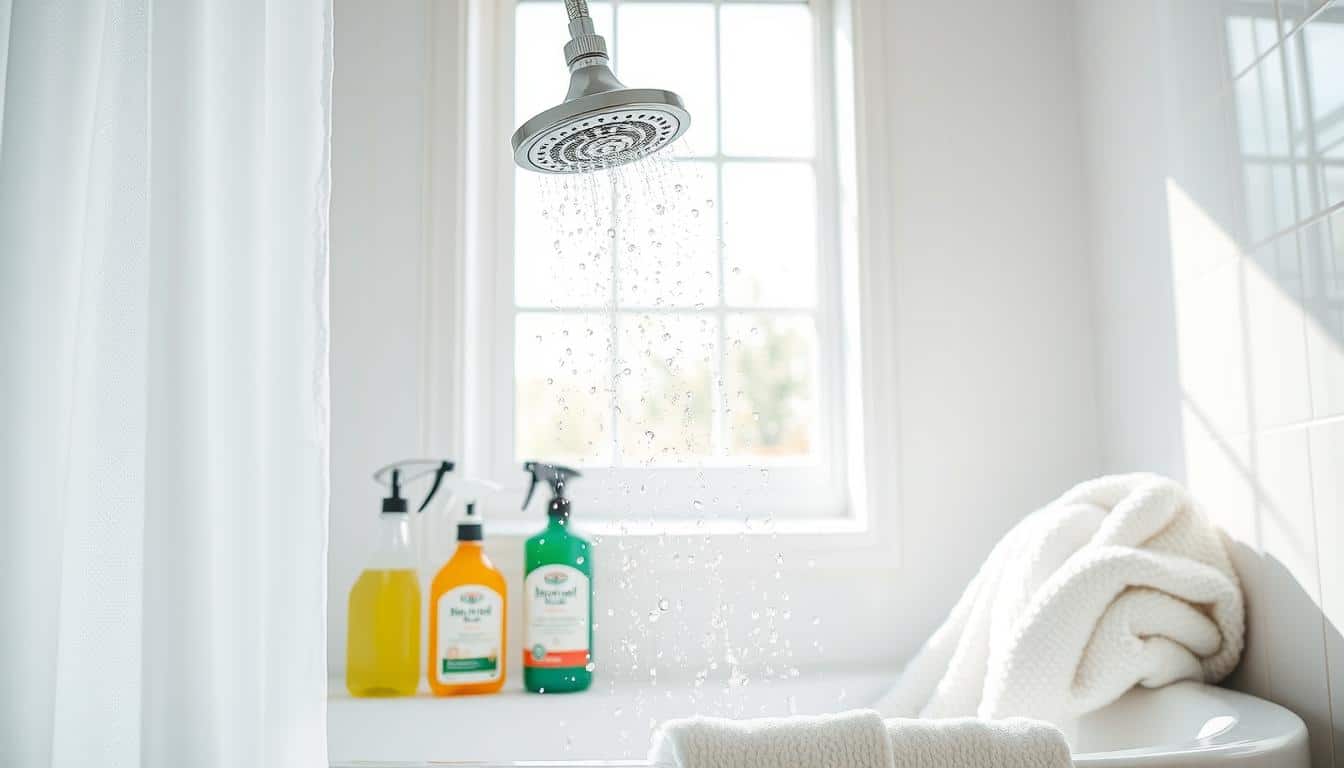Did you know that distilled white vinegar can kill 82 percent of mold species? This includes the most common ones found on shower curtains and liners. This fact shows how serious the mold problem is in bathrooms. It also shows why we need to clean well to keep our bathrooms healthy and mold-free.
I’m a professional copywriting journalist here to help you. I’ll show you how to remove mold from your shower curtains and stop it from coming back. In this article, we’ll explore why mold grows, the health dangers it poses, and how to fight it.
Key Takeaways
- Distilled white vinegar and cleaning vinegar are highly effective in killing mold on shower curtains.
- Baking soda, while not a mold killer, can be used to remove stains and discoloration left by mold spores.
- Proper ventilation and regular cleaning of shower curtains are crucial in preventing mold growth.
- Homemade cleaning solutions like vinegar and baking soda can effectively remove mold and mildew.
- Plastic or vinyl shower curtains should be washed regularly to maintain cleanliness and prevent mold buildup.
Understanding Mold Growth on Shower Curtains
Mold loves damp, warm places, making bathrooms perfect for it. Moisture from showers, poor air, and soap scum on curtains are ideal for mold growth.
Causes of Mold Growth in Bathrooms
Bathrooms are prone to mold because of high humidity and poor air flow. Also, mold feeds on organic materials found in bathrooms. These conditions help various types of bathroom mold grow.
Types of Mold Found in Bathrooms
- Cladosporium: A common black or green mold that can grow on shower curtains and other damp surfaces.
- Aspergillus: A greenish-yellow mold that can cause respiratory issues in sensitive individuals.
- Penicillium: A blue or green mold that can produce toxins and cause allergic reactions.
These mold types love the warm, humid bathroom environment. Shower curtains are a favorite spot for them to grow.
Maintaining proper humidity levels in the bathroom between 35% and 50% can reduce the likelihood of mold growth.
Health Risks of Shower Curtain Mold
Mold on shower curtains can be harmful, especially for those with allergies or breathing issues. Bathrooms are perfect for mold to grow, thanks to their dampness. Types like Cladosporium, Aspergillus, and Penicillium can cause problems.
Allergies and Respiratory Problems
Mold spores can make allergies worse or start new ones. Symptoms include sneezing, runny noses, itchy eyes, and skin rashes. These spores can also irritate the airways, leading to coughing and wheezing.
People with asthma or weakened immune systems are at higher risk. They need to avoid mold to stay healthy.
Skin and Eye Irritation
Mold can also irritate the skin and eyes. It can cause discomfort, redness, and swelling. If you’re sensitive, you might need to see a doctor.
It’s important to remove mold quickly. This stops it from spreading and keeps your home safe. Regular cleaning and effective removal can prevent mold and its health risks.

“Mold is a plant that releases spores into the air, and those spores can cause potential health issues like sneezing, coughing, or shortness of breath for people sensitive to them,” explains mold expert Nelson Barnes Jr.
To avoid mold allergies and respiratory problems from bathroom mold, fix the mold’s cause. This means better ventilation and less organic buildup. By stopping shower curtain mold early, you can make your home healthier and safer.
Pre-Cleaning Preparations
Before you start cleaning your shower curtain, it’s important to prepare. First, how to remove shower curtain for cleaning is key. Take it out carefully to avoid spreading mold spores. Put it in the washing machine or a bag, depending on its material.
Next, get the necessary cleaning supplies for mold. You’ll need vinegar, baking soda, hydrogen peroxide, or a bleach solution. Also, have scrubbing tools like a soft-bristle brush or sponge ready for tough stains.
Protective Gear for Mold Removal
Protecting yourself is crucial when cleaning mold. Wear protective gear for mold removal, like gloves and a mask. This keeps you safe from harmful spores.
By following these steps, you’ll be ready to remove mold from your shower curtain. This will make your bathroom healthier.

| Cleaning Supply | Purpose |
|---|---|
| Vinegar | Effective in killing mold and mildew |
| Baking Soda | Helps scrub and remove stubborn stains |
| Hydrogen Peroxide | Disinfects and whitens the curtain |
| Bleach Solution | Powerful for tackling tough mold growth |
Remember, safety is the most important thing when dealing with mold. Use proper protective gear for mold removal, like gloves and a mask. This will keep you safe while cleaning.
How to Remove Mold from Shower Curtains
Dealing with mold on your shower curtain can be frustrating. But, with the right steps, you can get rid of it and keep your bathroom clean. Here’s a simple guide to remove mold from shower curtains:
- First, check what your shower curtain is made of. Plastic or vinyl might need different cleaning than fabric.
- Next, take the curtain out and move it to a well-ventilated area. This stops mold spores from spreading in your home.
- Then, mix a cleaning solution. For plastic or vinyl, use white vinegar and water (1 tablespoon vinegar per 3 cups water). For fabric, add baking soda or a mild detergent to the wash.
- Scrub the curtain well with a soft-bristle brush or sponge. Focus on moldy spots.
- After scrubbing, rinse the curtain with clean water. Let it dry completely before putting it back up.
If the mold doesn’t come off easily, try soaking the curtain in a bleach solution (1 part bleach to 3 parts water) for up to 30 minutes. Make sure to ventilate the area well and wear protective gloves and eyewear when using bleach.
To stop mold from coming back, clean your shower curtains regularly. Experts say to do this two to three times a year, or more often in busy bathrooms. By following these step-by-step mold removal from shower curtains, your bathroom will stay fresh and mold-free.

Cleaning Plastic or Vinyl Shower Curtains
For plastic or vinyl shower curtains, vinegar and water is a great mix. Fill a spray bottle with equal parts white vinegar and water. Spray the curtain often to kill mold and mildew.
For tough mold stains, try a baking soda paste. Scrub the spots gently, then rinse. Baking soda and vinegar together can remove stubborn mold.
Using Vinegar and Baking Soda
- Mix equal parts white vinegar and water in a spray bottle
- Mist the curtain and let the vinegar soak in to kill mold and mildew
- Make a baking soda paste and gently scrub problem areas before rinsing
Bleach Solution for Tough Mold
If mold is still there, a bleach solution might help. But be careful with bleach. It can harm the curtain and your skin. Mix one part bleach with ten parts water. Test it on a small, hidden area first.
| Shower Curtain Material | Washing Machine | Hand Washing | Bleach | Ammonia | Vinegar & Baking Soda |
|---|---|---|---|---|---|
| PVC | ✔️ | ✔️ | ✔️ | ✔️ | ✔️ |
| PEVA / EVA | ✔️ | ✔️ | ❌ | ✔️ | ✔️ |
| Vinyl | ✔️ | ✔️ | ❌ | ✔️ | ✔️ |
| Nylon | ✔️ | ✔️ | ✔️ | ✔️ | ✔️ |
| Polyester | ✔️ | ✔️ | ❌ | ✔️ | ✔️ |
When cleaning plastic or vinyl curtains, avoid harsh chemicals. Use gentle, natural options like vinegar and baking soda for the best results.
Cleaning Fabric Shower Curtains
Fabric shower curtains attract mold and mildew because they are porous. But, you can clean them well to remove these fungi. A good way is to wash them in a machine with white vinegar and baking soda.
Machine Washing with Vinegar and Baking Soda
Always check the care label before washing your fabric shower curtain. You can usually use a gentle cycle with hot water. This helps kill mold spores and sanitize the fabric.
Add a cup of white vinegar to the wash. Vinegar’s acetic acid kills mold naturally. Baking soda helps remove tough mold stains or discoloration.
Don’t use fabric softener, as it attracts dirt and grime. This can lead to more mold. After washing, hang the curtain to dry. Avoid the dryer’s high heat, which can damage the fabric.
By washing with vinegar and baking soda, you can clean fabric shower curtains, wash moldy curtains, and stop future problems. Regular cleaning keeps your curtains looking good and mold-free.
“Mold and mildew spores thrive in moist environments, with bathroom humidity providing an ideal setting for their growth.”
Natural Remedies for Mold Removal
When dealing with mold in the bathroom, natural remedies are a good choice. Two effective options are hydrogen peroxide and tea tree oil.
Hydrogen Peroxide
Hydrogen peroxide is a mild bleach that kills mold spores and removes stains. Just pour it into a bowl, scrub the moldy spots, and let it sit for 15 minutes. Then, rinse it off. This method works in 70% of cases and keeps the surface clean.
Tea Tree Oil
Tea tree oil is a natural fungus fighter for moldy shower curtains. Mix a few drops with water in a spray bottle. Spray it on the curtain, let it sit, then wipe it clean. It’s a gentle yet strong way to fight mold.
Borax, with a pH level of 9.13, is effective in killing mold on all surfaces including wood and metal.
When using these natural remedies, safety is key. Wear a respirator, gloves, and eye protection for big mold jobs. Also, make sure the area is well-ventilated and sealed off to stop mold spores from spreading.
Using these natural methods in your bathroom cleaning can help fight mold. It keeps your bathroom healthy and mold-free. Remember, acting fast is important to stop mold from spreading and causing more damage or health problems.
When to Replace a Moldy Shower Curtain
Mold on your shower curtain is not just ugly; it’s also bad for your health. You should replace it if mold covers more than 10% of the area. Cleaning with a vinegar solution or baking soda paste can help, but big growths are hard to get rid of.
If mold keeps coming back after cleaning, it’s safer to get a new curtain. Moldy curtains can spread spores that cause allergies or breathing problems. It’s better to throw away a dirty curtain and start fresh for your health and a clean home.
Here are some signs you need a new shower curtain:
- Visible mold or mildew covering more than 10% of the surface
- Persistent musty odor that won’t go away with cleaning
- Discoloration or staining that can’t be removed
- Damaged or deteriorating material that’s no longer water-resistant
When you replace a moldy curtain, take it out carefully and put it in a sealed bag before throwing it away. This stops spores from spreading in your home. Pick a new curtain that’s water-resistant and easy to clean to avoid mold problems in the future.
Remember, your health and safety are most important when dealing with mold on shower curtains. Regular cleaning and replacing curtains can keep your bathroom clean and free of harmful fungi.
Preventing Future Mold Growth
It’s important to stop mold from growing on shower curtains to keep your bathroom clean and healthy. One key step is to make sure you have good ventilation. Running the exhaust fan or opening windows during and after showers helps reduce moisture. This is what mold and mildew need to grow.
Proper Ventilation
Good airflow is key to stopping mold on shower curtains. I always turn on the bathroom exhaust fan or open a window when showering. I keep it running for a few minutes after to get rid of extra humidity. This helps the curtain dry faster and prevents mold.
Routine Cleaning and Maintenance
I also clean my shower curtain regularly. I spray it with a vinegar-water mix and scrub off any mold or mildew. After cleaning, I hang the curtain out to dry quickly. I’m also thinking about getting a mold-resistant shower curtain. This way, I can keep my bathroom mold-free for good.
For more tips on stopping mold at home, check out Mold Remediators USA.
FAQ
What causes mold growth on shower curtains?
Mold loves damp, warm places with organic stuff. Bathrooms are perfect for it. Moisture from showers, poor air flow, and soap scum on curtains make a great mold home.
What are the common types of mold found in bathrooms?
In bathrooms, you’ll find Cladosporium, Aspergillus, and Penicillium. Each type has its own health risks.
What health risks are associated with mold exposure from shower curtains?
Mold on shower curtains can make you sick. It can cause allergies and breathing problems. It might make your eyes, skin, and airways itch, leading to sneezing, runny nose, and coughing. In bad cases, it can even trigger asthma attacks.
How should I prepare for the mold removal process?
Before you start removing mold, protect yourself. Remove the curtain carefully to avoid spores. Wear gloves and a mask. Put the curtain in the washing machine or a bag for safe disposal.
What are the effective methods for removing mold from plastic or vinyl shower curtains?
For plastic or vinyl curtains, vinegar works well. Mix equal parts vinegar and water in a spray bottle. Spray the curtain often to soak in the vinegar. For tough mold, make a baking soda paste and scrub before rinsing. If it’s still there, use diluted bleach carefully.
How can I remove mold from fabric shower curtains?
Machine wash fabric curtains to get rid of mold. Use hot water and a gentle cycle. Add vinegar and baking soda to the wash. Don’t use fabric softener. Let it air dry to avoid damage from heat.
What natural remedies can be used to clean mold from shower curtains?
For a natural clean, try hydrogen peroxide and tea tree oil. Hydrogen peroxide kills mold and lifts stains. Tea tree oil is a natural fungicide that can clean and disinfect.
When should I consider replacing a moldy shower curtain?
If mold covers more than 10% of the curtain, it’s time for a new one. Trying to clean it might not work, and health risks are too high.
How can I prevent future mold growth on my shower curtain?
Keep the air moving by using the fan or opening windows. Clean the curtain regularly with vinegar solution. Hang it to dry fully. Use mold-resistant materials to stop growth.




